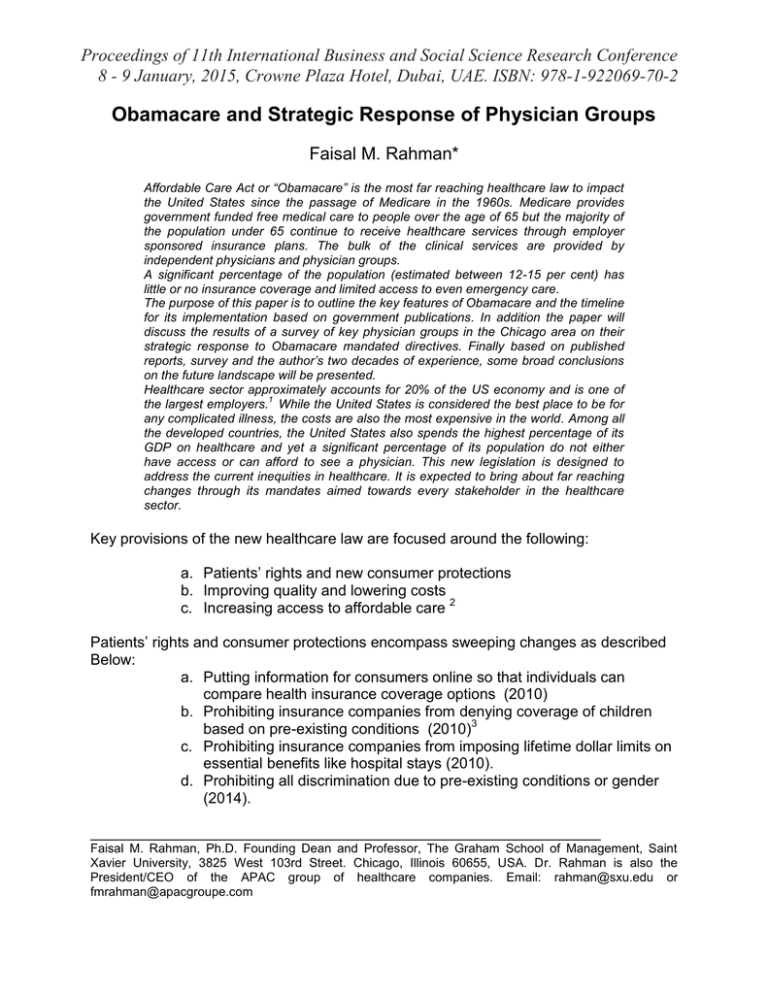Document 13317329
advertisement

Proceedings of 11th International Business and Social Science Research Conference 8 - 9 January, 2015, Crowne Plaza Hotel, Dubai, UAE. ISBN: 978-1-922069-70-2 Obamacare and Strategic Response of Physician Groups Faisal M. Rahman* Affordable Care Act or “Obamacare” is the most far reaching healthcare law to impact the United States since the passage of Medicare in the 1960s. Medicare provides government funded free medical care to people over the age of 65 but the majority of the population under 65 continue to receive healthcare services through employer sponsored insurance plans. The bulk of the clinical services are provided by independent physicians and physician groups. A significant percentage of the population (estimated between 12-15 per cent) has little or no insurance coverage and limited access to even emergency care. The purpose of this paper is to outline the key features of Obamacare and the timeline for its implementation based on government publications. In addition the paper will discuss the results of a survey of key physician groups in the Chicago area on their strategic response to Obamacare mandated directives. Finally based on published reports, survey and the author’s two decades of experience, some broad conclusions on the future landscape will be presented. Healthcare sector approximately accounts for 20% of the US economy and is one of 1 the largest employers. While the United States is considered the best place to be for any complicated illness, the costs are also the most expensive in the world. Among all the developed countries, the United States also spends the highest percentage of its GDP on healthcare and yet a significant percentage of its population do not either have access or can afford to see a physician. This new legislation is designed to address the current inequities in healthcare. It is expected to bring about far reaching changes through its mandates aimed towards every stakeholder in the healthcare sector. Key provisions of the new healthcare law are focused around the following: a. Patients’ rights and new consumer protections b. Improving quality and lowering costs c. Increasing access to affordable care 2 Patients’ rights and consumer protections encompass sweeping changes as described Below: a. Putting information for consumers online so that individuals can compare health insurance coverage options (2010) b. Prohibiting insurance companies from denying coverage of children based on pre-existing conditions (2010)3 c. Prohibiting insurance companies from imposing lifetime dollar limits on essential benefits like hospital stays (2010). d. Prohibiting all discrimination due to pre-existing conditions or gender (2014). _____________________________________________________________ Faisal M. Rahman, Ph.D. Founding Dean and Professor, The Graham School of Management, Saint Xavier University, 3825 West 103rd Street. Chicago, Illinois 60655, USA. Dr. Rahman is also the President/CEO of the APAC group of healthcare companies. Email: rahman@sxu.edu or fmrahman@apacgroupe.com Proceedings of 11th International Business and Social Science Research Conference 8 - 9 January, 2015, Crowne Plaza Hotel, Dubai, UAE. ISBN: 978-1-922069-70-2 Improving quality and lowering costs are designed to bring about the following changes: a. Provides small businesses health insurance tax credits. This affects almost 4 million businesses with employees fewer than 50 and provides credits up to 35% of the employer’s contribution to the employees’ health insurance (2010). b. All new insurance plans must cover certain preventive services such mammograms and colonoscopies without charging a deductible, copay or coinsurance. This is aimed at early detection and savings huge expenses when diseases are detected at a later stage (2010-2011). c. Creation of a public fund to promote health programs that can keep Americans healthy –from smoking cessation to combating obesity (2010). d. Increased funding to reduce fraud and waste in Medicare and Medicaid (2010). This program has been in effect even before the passage of Obamacare and has returned over $2.5 billion to the Medicare Trust Fund in 2009. e. Linking payments to quality outcomes through financial incentives and measurable results in key areas like heart failure, surgical outcomes and patient satisfaction (2012). f. Reducing paperwork and administrative costs through adoption of electronic health information and implementing it through a series of steps involving incentives and penalties (2012-2013). g. Piloting programs for hospitals, doctors and other providers to work together and a new payment system of “bundling” which pays a flat rate for an episode of care rather than the current fragmented system where each service is paid separately. The objective to create coordination of care, improve quality and prevent duplication of services. It is hoped that this would align incentives of those delivering care, and any savings will be shared between providers and Medicare programs (2013). h. Tax credits for individuals and families with income up to 400% of the poverty line. For example this makes a family of four with income up to $90,000 eligible for tax credit (2014). i. Mandates individuals to get health insurance or pay a fee to offset the cost of taking care of uninsured Americans. This is one of the most controversial provisions of the law (2014-2015). j. Paying physicians based on value of services received and not volume (2015). Increasing access to affordable care is to be achieved through the following – a. Young adults will be allowed to stay on their parents’ insurance plan till they turn 26 years old (2010-2011). Proceedings of 11th International Business and Social Science Research Conference 8 - 9 January, 2015, Crowne Plaza Hotel, Dubai, UAE. ISBN: 978-1-922069-70-2 b. Increased funding for primary care doctors and nurses to work in underserved areas and increasing payments to rural healthcare providers (2010-2011). c. Broadening the scope of Medicaid by subsidizing states to cover more low income people (2010). d. Increased funding and options to receive home healthcare for disabled individuals (2011). e. Mandating business with 50+ employees to provide employer sponsored insurance (2013). Different provisions of the law are being phased in over a period of five years in order to assure a smooth transition and prevent disruption of service. The year listed in parentheses of each provision described above is the planned year of implementation. In reality several implementation dates had to be postponed because of inadequate planning and inability of the government to develop various criteria for measurement of outcome. 3 The effect of Obamacare varies on who you are. For the patients, it means better access at possibly lower cost. For insurance companies a larger pool of people to sell. For small to medium sized businesses with 50+ employees, it is another government mandate which will translate into higher costs and could result in reduction of people in the current payroll. By far the most affected are physicians who are facing a scenario of lower reimbursements, higher costs, and competition from hospital employed physicians. They also feel ill equipped to meet the various reporting needs of government, insurance companies or making a case so that they can qualify for higher payments based on still-to-be-defined or ill- defined higher value care. Survey and discussion with the leaders of the large physician groups in the Chicago area indicated a sense of apprehension, loss of control but determination to stay independent. They understand that Obamacare, when fully implemented, will mean for them ---larger volume of patients, lower reimbursement, more paperwork/documentation and accountability. The physician groups’ strategic responses to Obamacare are in various stages of implementation. They include a. Increased Use of Physician Extenders – All physician groups understand that they will have to see more patients simply to maintain existing revenue level. They realize that is only possible if they use more and more physician extenders –primarily Nurse Practitioners and Physician Assistants. A single physicians can operationally and in most cases legally supervise/oversee 4 to 5 (depending on the state) PAs or NPs. The average cost of such extenders to the practice is 20 to 25% of that of a physician but their services are reimbursed at 85% of what a physician gets.4 b. Create Alternate Revenue Streams – Medium to large sized physician groups are beginning to acquire ancillary businesses with high profit Proceedings of 11th International Business and Social Science Research Conference 8 - 9 January, 2015, Crowne Plaza Hotel, Dubai, UAE. ISBN: 978-1-922069-70-2 c. d. e. f. g. margins. These ancillary opportunities include boutique single specialty hospitals, outpatient surgery centers, MRI centers, Labs for variety of screenings, Physical Therapy, Psych Services and even their pharmacies. Both costs and technology are aligned in favor of outpatient surgery centers. With increased attention on abuse of prescription drugs, labs for urine screening are sprouting up all around the United States. The incomes from such ancillaries are designed to offset the decline in reimbursement of traditional physician services. Direct contracting between providers (particularly physician groups and hospital networks) and large employers are beginning to get traction in certain parts of the country whereby the insurance companies are being bypassed. This is a unique development because historically insurance companies have made money both from employers and clinicians without any real risk by excluding patients with pre-existing conditions. An ironic situation given that the basic premise for the existence of an insurance company is payment for assuming risk. Obamacare will put some of the risk management business back into such entities where they belong. Direct contracting will be a key strategy for the physician groups in the future. Alliances with hospitals and independent physician groups are also developing across the country to take advantage of “bundle payments” with the intent of sharing “savings” with Medicare programs. Accountable Care Organizations (ACOs) are beginning to develop either led by physician groups or hospitals around the country. ACOs will be part of Obamacare strategic response of physician groups. 5 Physician groups are also participating and taking the lead in unique delivery systems like “doctor on demand” which matches a Board certified physician and patients for almost instant response to the latter’s need through “face time” over hand held mobile device or computer.6 There also seems to be a lack of coordinated response from physician groups to the expected takeover of “retail medicine” by in store clinics manned by Nurse Practitioners and operated by giants like CVS, Walgreens and Wal-Mart. Finally overwhelming majority of physician groups is in the very first phase of developing strategies to take advantage of payments which tie results with reimbursements. There is currently no consensus on any particular instrument which can objectively define value received by patients. Taking into account the politics of legislation, the impact of technology on healthcare delivery and influence of various stakeholders in the healthcare sector, we can reasonably expect the following trends – a. Obamacare in spite of resurgence of Republicans in the United States Proceedings of 11th International Business and Social Science Research Conference 8 - 9 January, 2015, Crowne Plaza Hotel, Dubai, UAE. ISBN: 978-1-922069-70-2 b. c. d. e. f. is here to stay. Albeit there will be fine tuning of the law as it has been the case with Medicare or even Social Security. United States will never become a single payer government run system. Independent physician groups will adjust, adapt and innovate and will continue to be a strong player. One or two man physician practices will disappear. Most areas of healthcare will move outpatient based on technology and costs and that will favor physician groups over acute care traditional hospitals. Healthcare delivery system at retail level will change driven by technology, just as online shopping is driving traditional retail sales down. Physician income will continue to trend down with a greater number being employed by hospitals and even insurance companies. Management will dominate healthcare decision making and operations in the foreseeable future. References: 1. www.Forbes.com February 2, 2014 2. www.hhs.gov/healthcare/facts/timelineline-text.html. November 28, 2014 3. McIntosh, James. Affordable Care Act: Insurance Coverage Has Improved for Young Adults. Medical News Today. September 9, 2014 4. www.physician practice.com Understanding Physician Assistant Reimbursement, February 17,2012 5. Hertz, Beth Thomas. A Look at Physician-led ACOs: What’s driving them and where they are headed. Medical Economics, June 12, 2013. 6. www.doctorsondemand.com



